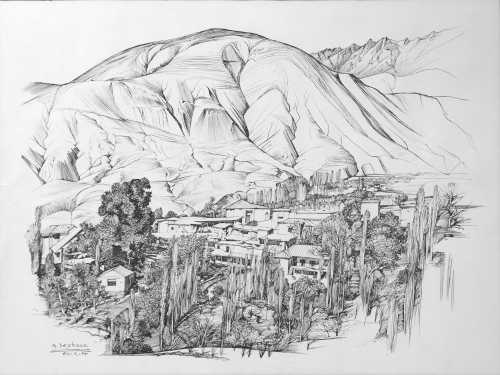About Hooshang Seyhoun
Hooshang Seyhoun, an architect, designer, painter, and sculptor, was born in Tehran in 1920. He is known as the father of modern Iranian architecture.
Seyhoun grew up in an artistic family, and his grandfather, Mirza Abdullah Farahani, is one of the pioneers of traditional Iranian music. Seyhoun graduated from Tehran University with a degree in architecture and went to Paris to continue his studies at the invitation of Andre Godard, the head of the Iranian Archeology Department at the time. He received his doctorate degree at the age of 25 from the National Institute of Fine Arts in Paris, Beaux-Arts de Paris, and returned to Iran. He began to build a monument for Iranian famous characters. The tombs of Khayyam, Ferdowsi, Nadershah Afshar, Kamal ol-Molk, and Abu Ali Sina are among his works.
In addition to architecture, Seyhoun taught at the University of Tehran and was the head of the Faculty of Fine Arts of the University of Tehran for six years. During this time, he established three fields: music, theater, and urban planning. He also drew and painted at the same time. He has held many exhibitions inside and outside of Iran. The exhibition of felt fish drawings in 1977 was an exhibition of his felt artworks.
The influence of architecture is apparent in his drawings and paintings. In his drawing collection of Italian churches and historical monuments, he mainly focused on the structure and architectural space, and in his drawings of Iranian villages, he especially paid attention to the connection between nature and architecture. In these drawings, Seyhoun usually went beyond the border of solid representation by choosing and combining different viewing angles and using smooth lines and hachures.
His most famous works are his semi-abstract drawings, known as coils. These artworks from the coils collection have been displayed in an exhibition in America alongside the work of Picasso and Dali. Seyhoun lived in Vancouver, Canada from the early 1980s until the end of his life in 2013.
The Most Expensive Artwork
At Auctions
First Attendance
16 October 2020
# Attendance
2
# Artworks
2
Average Realized Price
10,435 USD
Average Min Estimate
6,087 USD
Average Max Estimate
10,435 USD
Sell-through Rate
100%
Average Growth of Artwork Worth
26.316%
Timeline
In white exhibition
18 April
Timeless Creation exhibition
25 October
Auction 178 - Day 2 auction
19 July
A Glance at Sketching exhibition
8 March
Footprint exhibition
1 May
Painting, group exhibition exhibition
24 April
No.6 auction
16 October
Cama Chain exhibition
1 November
Composeds on Scaffolding exhibition
25 May
Architects Signature exhibition
27 October
